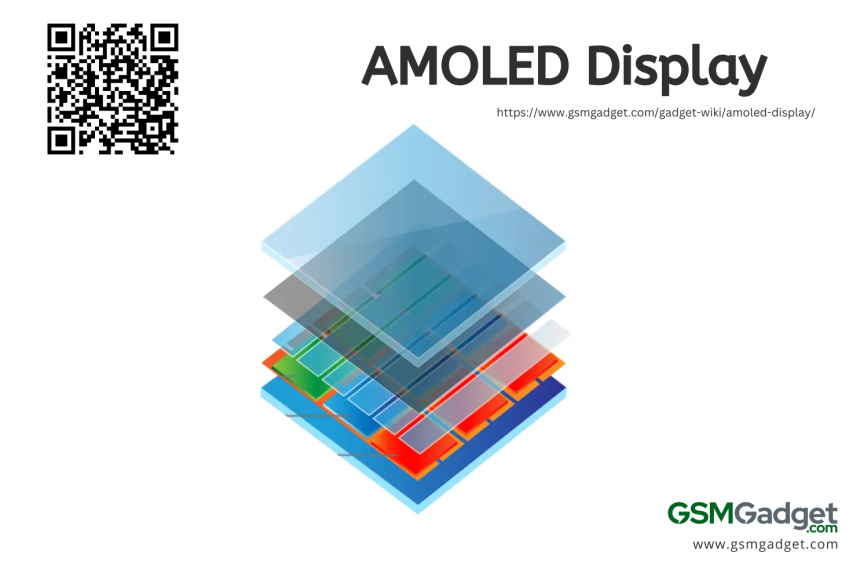An AMOLED (Active Matrix Organic Light Emitting Diode) display, which combines OLED technology with thin-film transistor (TFT) technology, is well-known for its superior image quality in devices such as smartphones, tablets, and TVs. This display technology features individual pixels made up of organic compounds that self-illuminate, eliminating the need for a backlight and allowing for the creation of thinner, flexible, or curved screens. AMOLED screens provide high contrast ratios, deep color saturation, and true blacks as pixels can be completely turned off. They are preferred for their quick response times, wide viewing angles, vibrant colors, and energy efficiency, particularly when displaying dark content. Despite these advantages, AMOLED displays are more expensive to manufacture and may experience image retention or burn-in with prolonged static image display.
AMOLED Display Technical specification
| Specification | Detail |
| Display Type | Active-Matrix Organic Light-Emitting Diode (AMOLED) |
| Screen Size | Varies by device (common sizes range from 5.0 inches to 6.9 inches diagonally) |
| Resolution | Varies per device (e.g., Full HD, Quad HD) – typically 1080 x 1920 pixels and above |
| Pixel Density | Typically ranges from 300 to 600 pixels per inch (PPI) |
| Touchscreen Type | Capacitive touchscreen with multi-touch capability |
| Color Depth | 16 million colors (24-bit), some up to 1 billion colors (30-bit) |
| Refresh Rate | Commonly 60Hz, 90Hz, 120Hz, or higher |
| Touch Sensitivity | Capacitive touchscreen with multi-touch support |
| Brightness | Typically ranges from 200 to 1300 nits or higher |
| Contrast Ratio | Very high (Typically 1,000,000:1) due to deep blacks and bright whites |
| Color Gamut | Wide color gamut support (e.g., DCI-P3, sRGB) |
| Response Time | Usually under 1 millisecond which is ideal for fast-moving content |
| Viewing Angles | Near 180 degrees without color shift |
| Power Consumption | Generally more power-efficient than LCD, especially with dark themes |
| Panel Thickness | Thin design, contributing to slimmer devices |
| Durability | Often paired with scratch-resistant glass; however, susceptibility to burn-in over time |
| Manufacturing Brands | Samsung, LG, BOE, and others |
| Technological Variants | Super AMOLED, Dynamic AMOLED, AMOLED Plus, etc. |
| Applications | Smartphones, smartwatches, foldable devices, VR headsets |
| Always-On Display | Available on certain models, showing time and notifications with minimal power consumption |
| Always-On Display | Available on certain models, showing time and notifications with minimal power consumption |
| HDR Support | HDR10/HDR10+ and Dolby Vision support, depending on the device |
| Color Accuracy | Calibrated for accurate color reproduction, with some models supporting DCI-P3 color space |
| In-Display Fingerprint Sensor | Available on certain models, allowing for fingerprint recognition directly on the screen |
| 3D Touch / Force Touch | Available on selected models, allowing different actions based on pressure applied |
Layers of AMOLED Display
AMOLED displays have revolutionized the way we interact with our devices, offering vivid colors and deep blacks that make every visual experience a delight. Let’s peel back the layers of this advanced screen technology to understand what makes it stand out in the crowded display market.
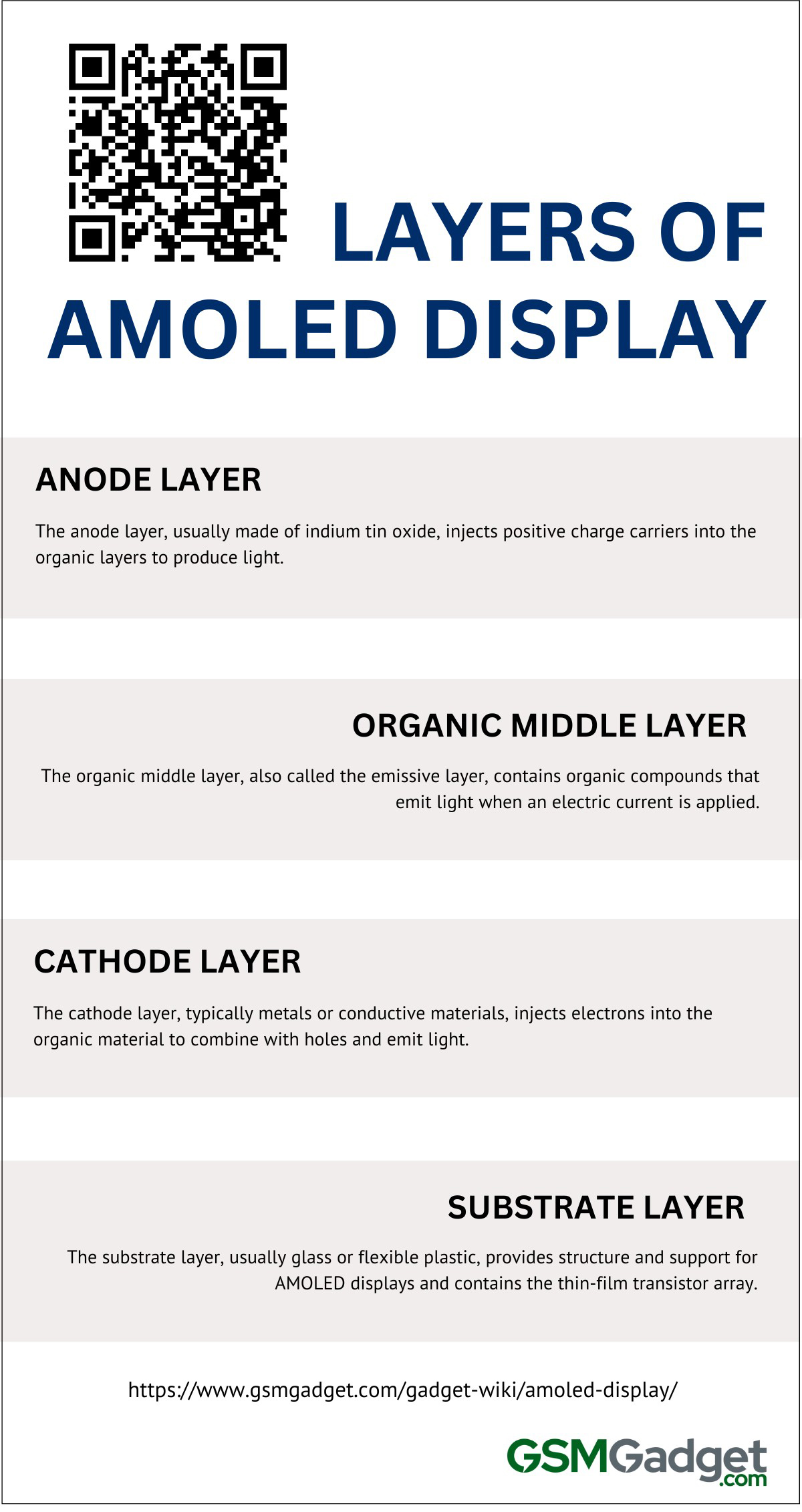
1. Anode layer
The anode layer of an AMOLED display is typically made from transparent conductive indium tin oxide (ITO) and is essential for the display’s operation and quality. It functions as the front electrode, introducing positive charge carriers into the organic layers to facilitate the recombination of holes and electrons in the emissive layer, which generates the light that produces vibrant images. This layer contains sub-layers such as the hole injection layer (HIL), which is often composed of materials like poly(3,4-ethylenedioxythiophene) polystyrene sulfonate (PEDOT:PSS) to improve hole injection efficiency. Applied onto a substrate of thin glass or plastic, the anode’s transparency and electrical conductivity are crucial for maintaining consistent brightness and the overall performance and efficiency of the display.
2. Organic middle layer
The functionality of an AMOLED display relies on its carefully engineered layers, with particular emphasis on the organic middle layer, also known as the emissive layer. This layer is made up of organic compounds that emit light when an electric current is applied, resulting in the vibrant colors that AMOLEDs are known for. Thin Film Transistors (TFTs) located above this layer serve as switches for controlling the current of individual pixels, while the cathode layer below helps with electron injection. The organic middle layer consists of multiple thin films, including the hole transport layer (HTL) and the electron transport layer (ETL), which work together to recombine positive and negative charges, ultimately producing light. This precise layering not only allows for light production but also contributes to the display’s slim design, energy efficiency, high contrast, and fast refresh rates. The specific organic materials used in the emissive layer determine the color of the light emitted, enabling the formation of red, green, and blue subpixels to create a full-color display.
3. Cathode layer
The cathode layer is a crucial component in AMOLED display panels, playing multiple roles to ensure optimal functionality and performance. Typically composed of metals like aluminum or calcium, as well as transparent conductive materials such as indium tin oxide (ITO), it is situated above the light-emitting layer and acts as the electron-injecting layer that facilitates electron flow when an electric current is applied. These electrons combine with holes from the anode layer in the organic material, resulting in the emission of light as photons. The efficiency of the cathode layer in conducting electrons is essential for the brightness and longevity of the display. It also includes features for specific functions, such as electrode chains for fingerprint identification, and is crucial for transmitting electrical signals within pixels, thereby enhancing display performance and reducing power loss. Additionally, it serves as a reflective surface to direct light towards the viewer and shield underlying organic layers from environmental degradation. In energy conversion devices like solid oxide fuel cells, optimizing the cathode layers, including the number of layers, is critical for maximizing efficiency and reducing area-specific resistance, ultimately improving overall device functionality.
4. Substrate layer
The substrate layer of the AMOLED display, typically made of glass or flexible plastic, is essential for its structure and performance. It serves as a transparent and conductive base that is coated with materials like indium tin oxide (ITO). On top of this layer is a thin-film transistor (TFT) array that controls individual pixels, as well as an organic layer that emits light in red, green, and blue to create a full color spectrum when electrically stimulated. Additional layers include electrodes for electron injection, a buffer to improve flexibility, and metal and cathode layers for functions such as fingerprint identification. To protect against environmental damage, an encapsulation layer is applied to ensure the display’s high contrast, vibrant colors, energy efficiency, and durability.
Comparing AMOLED vs OLED: Key differences
In the realm of smartphone displays, two acronyms frequently surface as buzzwords for quality: AMOLED and OLED. While they may sound similar, each offers unique advantages and technologies that cater to the diverse needs of smartphone aficionados.
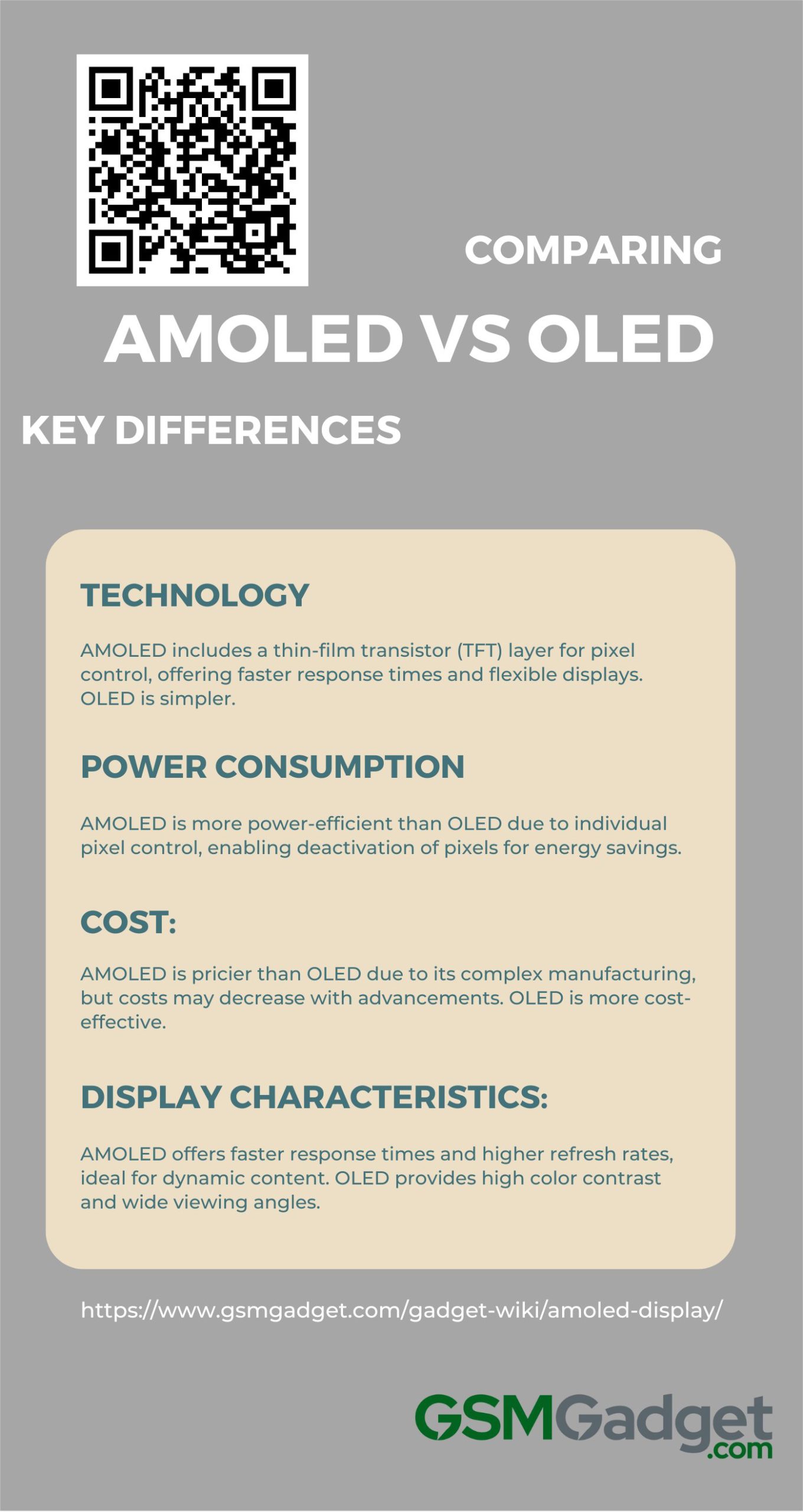
1. Technology
AMOLED and OLED technologies are transforming the display industry, particularly in mobile devices. OLED’s self-emitting properties and low power consumption have made it the preferred choice for high-end smartphones. Unlike LCDs that rely on backlights, OLED’s self-illumination provides wider viewing angles and more vibrant colors, making it a versatile and energy-efficient option. AMOLED, a more advanced version of OLED, incorporates a thin-film transistor (TFT) layer for precise control of current to each pixel. This allows for faster response times, higher refresh rates, and improved power efficiency. This technology not only enhances image quality but also enables thinner, flexible displays, leading to innovations like foldable phones. Despite the higher cost associated with the additional transistor layer, the benefits of AMOLED make it a significant advancement in display technology. Ongoing research is focused on further improving performance metrics such as external quantum efficiency.
2. Power consumption
Due mainly to active matrix technology, which allows for individual pixel control, AMOLED displays are typically more power-efficient than OLED displays. This allows AMOLED to deactivate pixels when displaying true black, saving energy. This feature is beneficial for devices like smartphones and smartwatches that prioritize battery life. On the other hand, OLED displays, while providing deep blacks and high contrast, tend to consume more power, especially when showing bright, white content as all pixels need to be fully activated. Efforts to enhance power efficiency in OLED technology involve improving external quantum efficiency and utilizing deep learning techniques to manage factors like saturation, brightness, and contrast without compromising display quality. Despite OLED’s lightweight and thin design, AMOLED’s precise power management and quick adoption in high-end smartphones due to consumer demand for innovative displays make it the more energy-efficient option for dynamic content scenarios.
3. Cost
AMOLED displays, commonly found in high-end smartphones and televisions, are more expensive than OLED displays due to their intricate manufacturing process. This process includes an active matrix of thin-film transistors (TFT) to control individual pixels, resulting in faster refresh rates and higher contrast ratios. On the other hand, OLED displays are more cost-effective, providing excellent color and contrast without the integrated TFT, making them a more affordable option for various consumer electronics. While AMOLED has been preferred for premium devices, OLED’s lower cost and environmental advantages, along with ongoing enhancements in efficiency and performance, make it a competitive option for a wide range of applications. As manufacturing methods progress, the cost difference between AMOLED and OLED is expected to decrease, making both technologies more accessible.
4. Display characteristics
Advanced display technologies like AMOLED and OLED use organic compounds to create rich blacks and vibrant colors. AMOLED displays utilize an active matrix of thin-film transistors (TFTs) to enable individual pixel control, resulting in faster response times, higher refresh rates, and energy efficiency. This makes them well-suited for dynamic content and flexible, bendable screens in high-end smartphones. On the other hand, OLEDs are self-luminous and simpler, as they do not require an additional TFT layer, allowing for thinner displays. They are often preferred for high-end TVs due to their color accuracy and uniform black levels when turned off. While AMOLED displays can sometimes display oversaturated colors, OLEDs are recognized for their high color contrast and wide viewing angles. Both technologies surpass traditional LCDs in terms of viewing angles and form factor, with AMOLED excelling in interactive content performance and OLEDs in display clarity and quality.
Types of AMOLED Display
The AMOLED display technology has revolutionized the smartphone industry, offering vivid visuals and deep blacks. Let’s explore the various types that enhance our gadgets’ viewing experience.
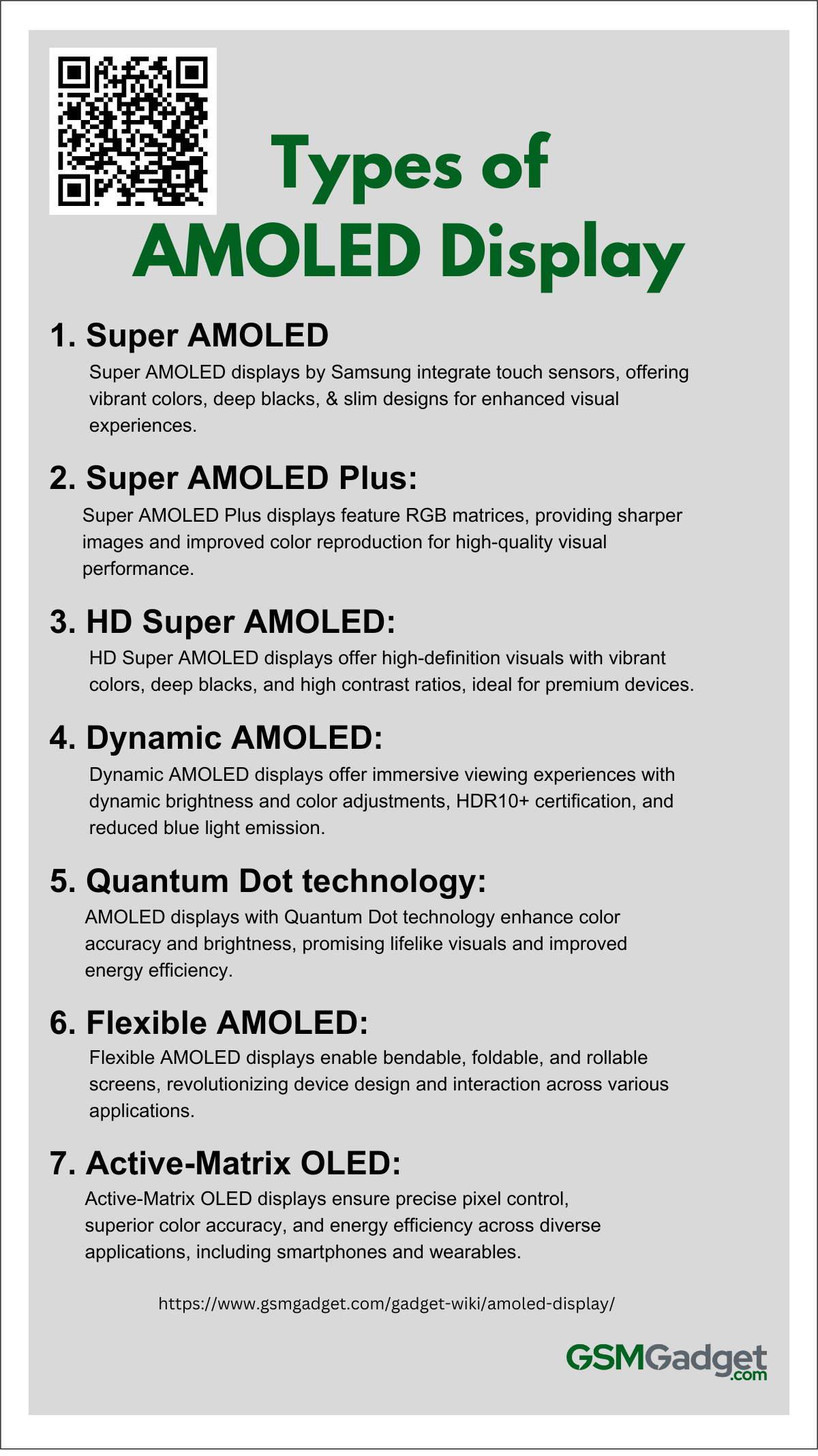
1. Super AMOLED
Super AMOLED displays, an advanced form of AMOLED technology developed by Samsung, have revolutionized the quality and efficiency of screens in modern electronic devices. These displays integrate the touch sensor within the screen itself, resulting in a slimmer profile, lower power consumption, and enhanced touch sensitivity. They are known for their high contrast ratios, deep blacks, and vibrant colors, with each pixel individually illuminated to provide a brighter and more responsive visual experience. Variations such as Super AMOLED Plus, Super AMOLED Advanced, and Dynamic AMOLED offer improvements such as true-to-life color reproduction, higher resolutions, and pixel densities, as well as HDR10+ support for a broader color spectrum and reduced blue light emission. These innovations cater to diverse user preferences, balancing color accuracy, visual comfort, and power efficiency, making Super AMOLED displays a significant upgrade over traditional LCD and regular AMOLED screens, especially for mobile devices like smartphones and tablets.
2. Super AMOLED Plus
Super AMOLED Plus displays are an advanced form of AMOLED technology known for their superior visual performance and efficiency. These displays are constructed with multiple layers, including a storage capacitor, transparent conductive films, and a water-absorbing buffer layer to protect the organic light-emitting layer. They utilize a traditional RGB matrix, which provides more sub-pixels for sharper, more detailed images, and improved color reproduction. The integration of touch sensors within the display itself leads to a thinner design and reduced glare. Super AMOLED Plus screens also feature optimized scanning signal lines to lower power consumption in idle modes and have unique pixel configurations that enhance blue sub-pixel performance. This technology is part of a broader AMOLED family, which includes variations like Dynamic AMOLED with HDR10+ certification and higher refresh rates, offering diverse benefits for different devices and user preferences.
3. HD Super AMOLED
HD Super AMOLED displays, developed by Samsung, are a high-definition version of AMOLED technology that offer improved visual performance with vibrant colors, deep blacks, and high contrast ratios. These screens have a higher pixel density for sharper, more detailed images and incorporate the touch sensor directly into the display, resulting in thinner devices. Variants such as Full HD and Quad HD Super AMOLED provide even higher resolutions, while Super AMOLED Plus and Dynamic AMOLED enhance pixel layout and color range to cater to various user preferences for resolution, color accuracy, and power efficiency. These displays are commonly found in mid-range to high-end devices, delivering a premium viewing experience.
4. Dynamic AMOLED
Dynamic AMOLED displays, developed by Samsung, represent a significant advancement in AMOLED technology, providing an immersive viewing experience with dynamic adjustments in brightness and color range. These displays feature high contrast ratios, HDR10+ certification, and reduced blue light emission. Variants such as Dynamic AMOLED 2X and Adaptive Dynamic AMOLED improve peak brightness, color accuracy, and battery efficiency through adaptive refresh rates. These displays are well-suited for premium smartphones and tablets, allowing for curved and edge-to-edge designs, supporting dynamic tone mapping for real-time optimization, and contributing to longer battery life due to their energy efficiency. Overall, they are a preferred choice for a visually stunning and lifelike display experience.
5. AMOLED with Quantum Dot technology
Quantum Dot (QD) technology in AMOLED displays, including QLEDs and QD-OLEDs, represents a notable advancement due to its superior color accuracy, efficiency, and brightness. QD-OLEDs, in particular, merge OLEDs with Quantum Dots to elevate visual quality, resulting in a broader color gamut and lifelike visuals through the use of nanoscale semiconductor crystals that convert light into precise colors. These technologies not only enhance color representation and viewing angles but also offer improved energy efficiency and longevity, indicating a significant impact on the future of high-resolution screen technology for a variety of devices.
6. Flexible AMOLED
Flexible AMOLED displays are revolutionizing screen technology by their ability to bend, fold, and roll, catering to a wide range of applications from smartphones to wearables. These displays incorporate features such as wireless charging and touch sensors, and are available in various forms: durable plastic substrates for everyday devices, foldable screens for versatile use, rollable displays for adjustable form factors, and stretchable screens for innovative device shapes. Samsung’s Super AMOLED technology enhances the user experience by integrating touch sensors within the display, resulting in thinner devices and improved viewing quality. Each advancement showcases the potential of flexible AMOLEDs to transform device interaction and design.
7. Active-Matrix OLED (AMOLED)
Active-Matrix OLED (AMOLED) displays are known for their precise control of pixels, superior color accuracy, and energy efficiency. They have evolved into various forms to meet diverse application needs. Traditional AMOLEDs are commonly used in smartphones and wearables, while Samsung’s Super AMOLED integrates touch sensors for a slimmer, more power-efficient design. Flexible and P-OLED variants offer durability and adaptability for foldable devices, and Transparent AMOLEDs enable innovative see-through displays. These advancements maintain the core advantages of OLED technology, such as high contrast ratios and deep blacks, while enhancing image quality and user experience across devices like mobile phones, laptops, and televisions.
Advantages of AMOLED Displays
AMOLED displays have revolutionized the smartphone industry by offering superior visuals and energy efficiency. Users savor the vibrant colors and deep blacks, which make every interaction with their device a visually stunning experience.
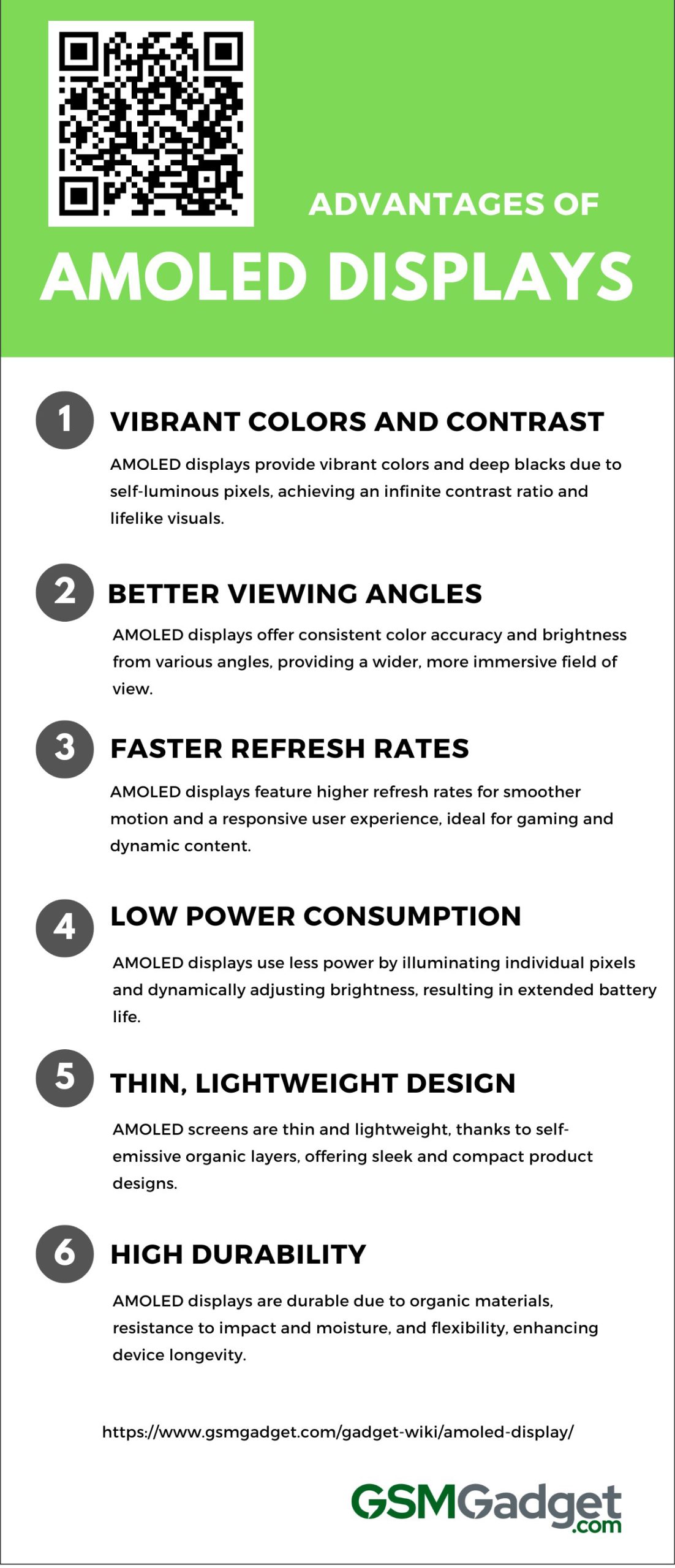
1. Vibrant Colors and Contrast
AMOLED (Active-Matrix Organic Light-Emitting Diode) displays offer significant advantages over traditional LCD screens, particularly in terms of vibrant colors and high contrast. The self-luminous pixels in AMOLED panels emit light independently, eliminating the need for a backlight. This allows for true blacks to be achieved by completely turning off unnecessary pixels, resulting in an infinite contrast ratio. This capability enables deeper blacks and a wider color gamut that is 1.3 times larger than that of LCDs, allowing for the reproduction of a broader and more accurate range of vivid, lifelike colors. The high contrast ratio enhances the vibrancy and saturation of colors, improving the visual appeal and making high-definition videos and graphics appear with exceptional clarity and depth, providing an immersive viewing experience.
2. Better Viewing Angles
Conventional LCD (Liquid Crystal Display) screens are not as popular as AMOLED displays due to their inconsistent brightness and lack of color fidelity across a larger viewing angle. This advantage is attributed to the self-emissive properties of AMOLED, where each pixel emits its own light, eliminating the color shifting and brightness loss experienced by LCDs that rely on a backlight. The technology of AMOLED allows for individual pixel control, resulting in precise and vibrant images, and supports the creation of curved and foldable screens, enhancing the viewing experience with a wider, more immersive field of view. These characteristics make AMOLED displays particularly beneficial for devices such as smartphones, smartwatches, and televisions, where clear visibility from different angles is essential.
3. Faster Refresh Rates
With their quicker refresh rates (often ranging from 90Hz to 120Hz or more), AMOLED screens offer a significant advantage over standard LCD screens. Deep blacks and vibrant colors are what they are known for. These higher refresh rates allow the display to update images more frequently per second, resulting in smoother motion and a more responsive user experience. This is particularly beneficial for dynamic content such as video playback, gaming, and scrolling. The ability of AMOLED screens to illuminate individual pixels enables efficient synchronization with the device’s GPU, enhancing on-screen motion fluidity. This leads to reduced motion blur, improved touch responsiveness, and a sharper visual output, giving gamers and professionals who rely on quick reflexes and precision a competitive edge. Additionally, variable refresh rates in AMOLED displays contribute to improved luminance uniformity and reduced flicker levels, further enhancing the user experience with a smooth, responsive, and immersive visual performance.
4. Low Power Consumption
AMOLED displays, known for their low power consumption, are particularly beneficial for portable electronics where battery longevity is essential. This technology allows each pixel to produce its own light, eliminating the need for a traditional backlight as seen in LCD screens. This feature is crucial for its energy efficiency, as it can deactivate pixels when displaying true blacks and dynamically adjust the brightness for each pixel based on the content, resulting in significant power savings. The high contrast ratio and ability to display deep blacks without power consumption in those areas further enhance the energy efficiency of AMOLED screens. As a result, devices equipped with AMOLED technology, such as smartphones and smartwatches, experience extended battery life and reduced charging frequency, enhancing the user experience and conserving energy.
5. Thin, Lightweight Design
The cutting-edge technology used in AMOLED panels makes them renowned for having a tiny and light profile. Organic layers that emit light on their own to achieve this reduce the requirement for a large backlight. The reduction in thickness and weight not only enhances the aesthetic and portability of devices such as smartphones, tablets, and wearables, but also reduces shipping costs and improves user comfort during extended use. The slim design of AMOLED screens enables easy integration into space-limited environments and supports flexible mounting options, making them suitable for a variety of applications. Their lightweight nature simplifies installation and contributes to sleeker, more compact product designs, which is particularly beneficial for handheld devices where ease of handling is important.
6. High Durability
One of the main reasons that AMOLED screens are preferred over other panel technologies is their extraordinary longevity. The use of organic materials in AMOLED technology inherently provides resistance to physical impacts, contributing to a lower likelihood of damage from drops and environmental factors like moisture. The flexible nature of AMOLED screens allows them to better absorb shocks, which, combined with the absence of a backlight, results in fewer layers prone to failure, thereby enhancing device longevity. Furthermore, the implementation of AC biased pixel circuits with a-IGZO thin film transistors compensates for threshold voltage variations and OLED degradation, further extending the lifespan and reliability of these displays. The combination of vivid colors, deep blacks, and structural resilience not only ensures a superior viewing experience but also positions AMOLED screens as a robust choice in the market.
Disadvantages and Limitations of AMOLED Display
While AMOLED displays are celebrated for their vibrant colors and deep blacks, they also come with a set of drawbacks that smartphone users should consider. These limitations can affect the longevity, performance, and overall user experience of your device.
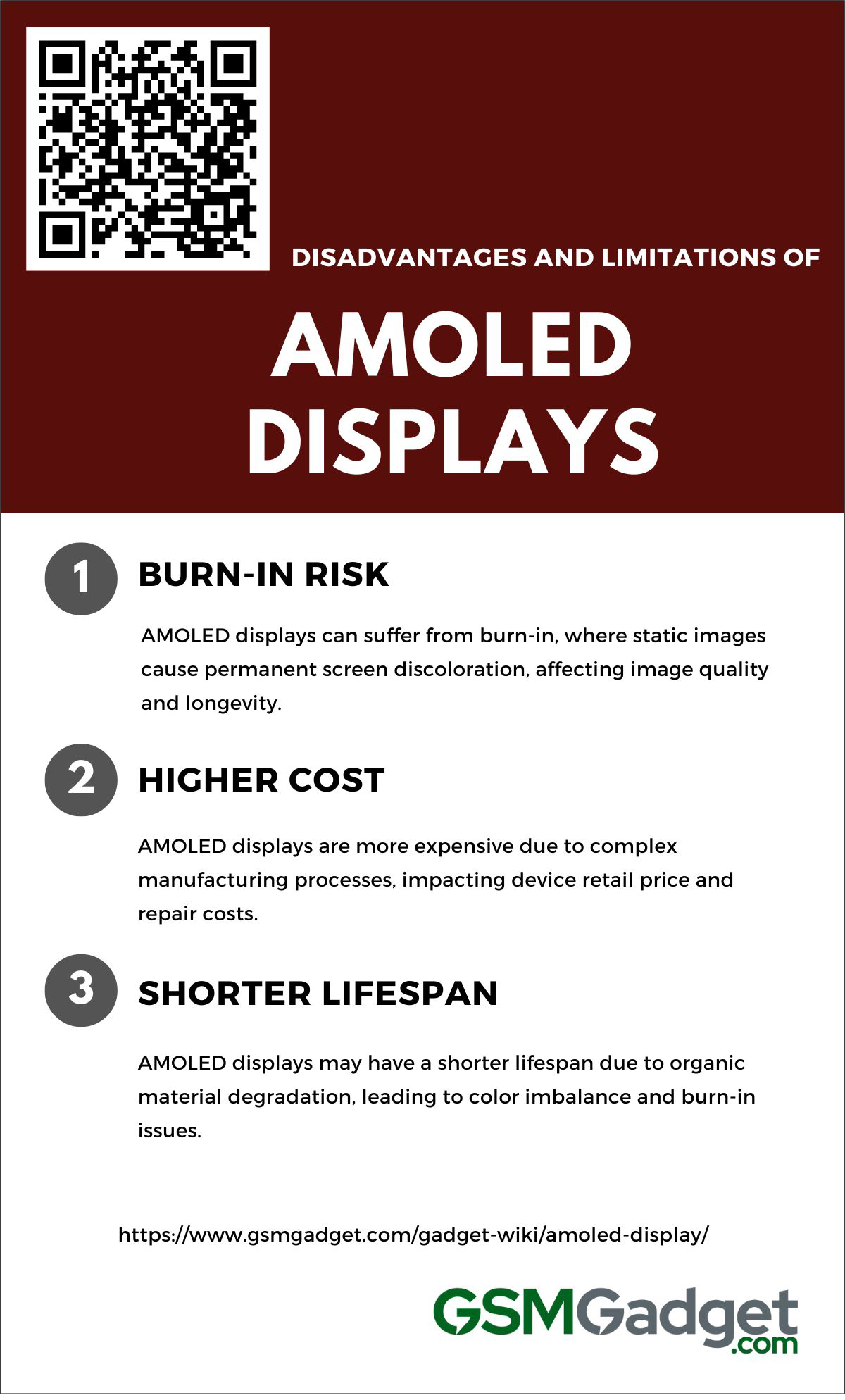
1. Burn-In Risk
Although AMOLED screens are praised for having rich blacks and vibrant colors, they are prone to burn-in, a condition where persistent static images cause permanent screen discoloration due to the degradation of organic compounds. This effect leads to uneven pixel wear and luminance discrepancies, creating ghostly afterimages that can mar the viewing experience and hinder the display of new content. Strategies to combat this issue include burn-in compensation techniques that adjust pixel luminance, external compensation, and luminance control based on user visual acuity, which aim to optimize current flow and minimize the effects of static image display. Manufacturers also employ measures like pixel shifting and suggest users avoid constant display of static elements. However, despite these preventive efforts, burn-in remains a significant concern for AMOLED screens, urging continuous research for improved longevity and users to adopt habits such as screen savers and content variation to preserve their device’s screen.
2. Higher Cost
Deeper blacks and better color contrast are two characteristics of AMOLED screens, but these come at a higher cost due to their sophisticated manufacturing process, making them more prevalent in high-end smartphones and advanced flexible screen applications. The production involves complex fabrication methods, including the use of fine metal masks and organic materials that lead to increased expenses. This technology’s inherent lower power consumption than LCDs still presents a need for optimization to develop more cost-effective materials and structures, particularly for novel applications like transparent and bendable screens. The high cost not only impacts the retail price, making AMOLED-equipped devices less accessible for cost-conscious consumers, but also affects repair and replacement expenses due to the pricey panels and potential degradation of organic compounds over time. Despite the visual and power efficiency advantages, these financial implications hinder AMOLED technology’s widespread adoption across various display technologies.
3. Shorter Lifespan
AMOLED displays, known for their vivid colors and contrast, have made impressive strides in extending their lifespan, with some panels now surpassing 50,000 hours of usage. However, these screens have inherent disadvantages due to the organic materials they are made from, which degrade over time, particularly when exposed to oxygen, moisture, and UV light. This degradation can lead to issues such as burn-in—where images are permanently imprinted on the display—and a decline in brightness and color accuracy, as the blue light-emitting diodes decay more rapidly than red and green ones. This results in color imbalance over time and a shorter overall lifespan compared to other display types. These challenges are crucial for users looking for device longevity and also pose environmental concerns, as the need for more frequent replacements could result in increased electronic waste.
